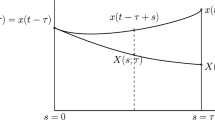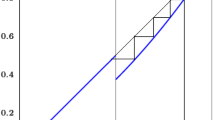Abstract
A general version of a model of Ebenman for the dynamics of a population consisting of competing juveniles and adults is analyzed using methods of bifurcation theory. A very general existence results is obtained for non-trivial equilibria and non-negative synchronous two-cycles that bifurcate simultaneously at the critical valuer=1 of the inherent net reproductive rater. Stability is studied in this general setting near the bifurcation point and conditions are derived that determine which of these two bifurcating branches is the stable branch. These general results are supplemented by numerical studies of the asymptotic dynamics over wider parameter ranges where various other bifurcations and stable attractors are found. The implications of these results are discussed with respect to the effects on stability that age class competition within a population can have and whether such competition is stabilizing or destabilizing.
Similar content being viewed by others
Literature
Cushing, J. M. 1988. “Non-Linear Matrix Models and Population Dynamics.”Nat. Resources Modeling 2, 539–580.
Ebenman, B. 1988. “Competition Between Age Classes and Population Dynamics.”J. theor. Biol. 131, 389–400.
— 1987. “Niche Difference Between Age Classes and Intraspecific Competition in Age-Structured Populations.”J. theor. Biol. 124, 25–33.
Fujii, K. 1968. “Studies on Interspecies Competition Between the Azuki Bean Weevil and the Southern Cowpea Weevil—III. Some Characteristics of Strains of Two Species”.Res. Popul. Ecol. 10, 87–98.
Hamrin, S. F. and L. Persson. 1986. “Asymmetrical Competition Between Age Classes as a Factor Causing Population Oscillations in an Obligate Planktivorous Fish Species.”Oikos 47, 223.
Harcourt, D. G. 1971. “Population Dynamics ofLeptinotarso decemlineata (Say) in Eastern Ontario.”Can. Entomol. 103, 1049.
Hassell, M. P., J. H. Lawton and R. M. May. 1976. “Patterns of Dynamical Behaviour in Single-Species Populations.”J. Anim. Ecol. 45, 471–486.
Krebs, C. J. 1972.Ecology: The Experimental Analysis of Distribution and Abundance. New York: Harper & Row.
Lack, D. 1954.The Nature Regulation of Animal Numbers. Oxford University Press.
May, R. M. 1976.Theoretical Ecology: Principles and Applications. Philadelphia, PA: Saunders.
—, G. R. Conway, M. P. Hassell and T. R. E. Southwood. 1974. “Time Delays, Density-Dependence and Single-Species Oscillations.”J. Anim. Ecol. 43, 747–770.
Tschumy, W. O. 1982. “Competition Between Juveniles and Adults in Age-Structured Populations.”Theor. Popul. Biol. 21, 255–268.
Author information
Authors and Affiliations
Additional information
Supported by National Science Foundation Grant No. DMS-8714810.
Rights and permissions
About this article
Cite this article
Cushing, J.M., Li, J. On Ebenman's model for the dynamics of a population with competing juveniles and adults. Bltn Mathcal Biology 51, 687–713 (1989). https://doi.org/10.1007/BF02459656
Received:
Revised:
Issue Date:
DOI: https://doi.org/10.1007/BF02459656




